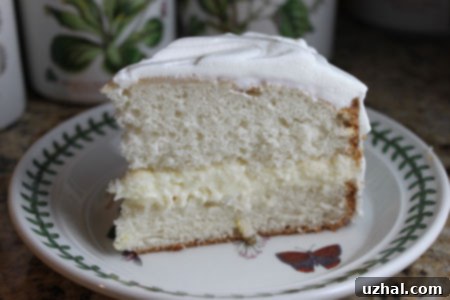The Ultimate Lemon Cream Cake: A Zesty Delight for Every Occasion
There’s something inherently delightful about a lemon dessert. The bright, tangy notes awaken the palate, while a creamy texture provides a comforting richness. This particular lemon cream-filled cake perfectly embodies that balance, delivering an unforgettable experience that’s both refreshing and indulgent. While the original recipe for this gem dates back some time, its core takeaway remains eternally true: the lemon cream filling is simply exceptional. It transforms even the simplest base into a show-stopping dessert, proving that sometimes, the true artistry lies in the filling. We’ve taken the essence of that beloved old post and expanded upon it, refining the details and adding more insights to help you recreate this zesty masterpiece in your own kitchen.
In this comprehensive guide, we’ll delve into everything you need to know to make a spectacular lemon cream cake. Whether you opt for the ultimate convenience of a store-bought cake mix or prefer the satisfaction of baking from scratch, the star of this recipe—the luscious lemon cream filling—will elevate your creation to gourmet heights. We’re focusing on making this recipe accessible and enjoyable, ensuring that the process is as smooth as the filling itself. So, get ready to discover your new favorite lemon dessert!

Embracing Convenience: Boxed White Cake with Lemon Cream Filling
Our journey to lemon cream cake perfection often begins with a simple, yet surprisingly versatile, base: a boxed white cake mix. While the purists might insist on baking from scratch, there’s absolutely no shame in embracing the convenience that a good quality cake mix offers. In fact, it’s a brilliant hack that allows you to focus your culinary energy on what truly makes this cake extraordinary: the lemon cream filling. This cake is so good, we’re still enjoying slices of it, and the craving to make it again is already strong! The sheer simplicity of pairing a fluffy white cake with this bright, tangy filling creates a dessert that feels far more elaborate than its humble origins suggest.
The beauty of starting with a boxed cake mix is twofold: it’s incredibly easy to prepare, requiring minimal skill and effort, and it provides a consistent, reliable texture. This allows you to channel your creativity and precision into crafting the star of the show – the exquisite lemon cream filling. For many busy home bakers, this approach is a game-changer, enabling them to create a dessert that tastes homemade without the extensive time commitment. The contrast between the light, airy cake layers and the rich, zesty filling is truly what makes this cake a standout. We’ve presented it here between layers of a plain white boxed cake, demonstrating just how impactful that filling can be.
While a boxed mix proved to be a fantastic foundation for our initial creation, the thought of elevating this dessert further with a homemade cake base is definitely on the horizon. Perhaps a delicate sponge cake or a rich butter cake would provide an interesting textural contrast. However, on this particular occasion, a box of white cake mix serendipitously resided in the pantry, practically begging to be transformed into something delicious. The vision was clear: a light, tender cake, elegantly split and layered with a generous dollop of lemon cream, all enveloped in a complementary frosting. This dream became a delicious reality, proving that culinary inspiration can strike even with the simplest of ingredients at hand.
Baking Your Cake Base
The first step in assembling our magnificent lemon cream cake is to prepare the cake base. Whether you’re using a box mix or your favorite scratch recipe, the baking process is crucial for a cake that’s light, tender, and easy to work with. For this recipe, we baked a white cake in a 9-inch round springform pan, approximately 3 inches high. Springform pans are particularly useful for delicate cakes like this, as their removable sides allow for easy release without damaging the cake’s structure. Be sure to properly grease and flour your pan to prevent sticking.
Follow the instructions on your cake mix box precisely, or your chosen scratch recipe, ensuring you don’t overmix the batter. Overmixing can lead to a tough, dry cake, which is the last thing we want. Bake the cake at the recommended temperature (typically 350°F / 175°C) until a toothpick inserted into the center comes out clean. This usually takes around 43-45 minutes for a 9-inch cake. Once baked, let the cake cool in the pan for about 15-20 minutes. This allows it to firm up slightly before you attempt to invert it. Carefully release the cake from the springform pan, then invert it again onto a wire rack to cool completely. Patience during this cooling stage is key; a warm cake will crumble when split and melt your delicate filling.
Precision Layering: My Favorite Gadget for Splitting Cakes
Once your cake is completely cool, it’s time for an important step: splitting it into even layers. This is where a fantastic kitchen tool truly shines. My absolute favorite gadget for achieving perfectly even cake layers is a good quality cake lifter, used in conjunction with a long serrated knife. I’ve sung its praises before, and for good reason—it’s an incredibly handy tool that makes what could be a tricky task remarkably simple. Even if you only bake cakes occasionally, investing in a cake lifter is well worth it for the precision and ease it brings to your baking endeavors.
The primary benefit of a cake lifter when splitting cakes is its ability to provide stable support. After making your initial cut around the cake with a serrated knife (creating a guiding groove), you can gently insert the cake lifter into that groove, carefully working your way around to ensure an even split. This prevents the top layer from tearing or collapsing, which is a common frustration when relying solely on a knife. Beyond splitting, a cake lifter is, as its name suggests, perfect for transferring entire cakes or delicate halves from one surface to another. Whether you’re moving a cooled cake from a rack to a serving plate, or positioning a fragile layer onto your filling, this gadget offers the stability you need. While the cake was baking and cooling, I dedicated my time to preparing our star attraction – the exquisite lemon cream filling. Once both components were ready, I carefully split the cake, returned the bottom half to the springform pan for easy assembly, and then generously added the filling.
Crafting the Luscious Lemon Cream Filling
Now, let’s turn our attention to the soul of this dessert: the lemon cream filling. This bright, tangy, and incredibly smooth filling is surprisingly easy to make and forms the perfect counterpoint to the sweet cake. It combines the vibrant flavor of fresh lemon with the richness of cream cheese, resulting in a truly irresistible texture and taste. The beauty of preparing the filling while the cake bakes and cools is that everything comes together seamlessly, allowing for efficient baking.
The process begins on the stovetop, where granulated sugar, cornstarch, and water are whisked together in a saucepan. Cornstarch is our secret weapon here, providing the necessary thickening power to achieve that perfect creamy consistency. Fresh lemon juice is then whisked in, bringing its signature zesty punch, followed by two large egg yolks, which contribute to the richness and smooth texture. The mixture is then cooked over medium heat, requiring constant whisking. This continuous motion is crucial to prevent lumps and ensure even cooking. As the mixture heats, it will begin to boil and thicken. Continue whisking steadily for an additional minute after it reaches a boil to ensure the cornstarch is fully cooked out and the filling achieves its maximum thickness. Immediately remove the pan from the heat and stir in the lemon zest – this infuses the filling with an intense, aromatic citrus flavor – and softened cream cheese. The residual heat from the filling will help the cream cheese melt smoothly into the mixture, creating an unbelievably creamy and slightly tangy base. Set this vibrant lemon mixture aside to cool completely. Once the lemon mixture has cooled, a crucial final step is to gently fold in whipped heavy cream. This aerates the filling, making it wonderfully light and truly “creamy,” transforming it into the delightful consistency that makes this cake so special.
Assembling and Chilling for Perfect Harmony
With both the cooled cake layers and the irresistible lemon cream filling ready, it’s time to bring our masterpiece together. This stage requires a gentle hand and a bit of patience, especially when it comes to the chilling process, which is essential for the filling to set beautifully and for the flavors to meld. Start by carefully splitting your cooled cake horizontally into two even layers, using your serrated knife and cake lifter as previously described. Place the bottom half of the cake, cut side up, back into your cleaned springform pan. This provides a helpful boundary, keeping the filling neatly contained and ensuring a clean final presentation.
Next, lavishly spread the prepared lemon cream filling over the cut surface of the bottom cake layer, ensuring an even distribution right to the edges. Don’t be shy with the filling; it’s the star! Once the filling is spread, carefully place the second half of the cake on top, gently aligning it. Once assembled, cover the entire cake snugly with plastic wrap and transfer it to the refrigerator. Chilling is a non-negotiable step for this cake. While four hours would likely be sufficient for the filling to set firm enough to slice, an overnight chill is truly ideal. This extended period allows the lemon cream filling to fully firm up, making for cleaner cuts and a more stable cake. More importantly, it gives all the flavors—the subtle sweetness of the cake, the bright tang of the lemon, and the richness of the cream—ample time to marry and deepen, resulting in a more harmonious and delicious dessert. This chilling time also gives you a welcome break to ponder your frosting strategy, ensuring you choose the perfect topping for your chilled creation.
The Perfect Finishing Touch: Whipped Cream and Sour Cream Frosting
After the essential chilling period, your lemon cream cake is ready for its grand finale: the frosting. The choice of frosting can significantly impact the overall flavor profile and texture of the dessert. For this particular cake, a light and tangy whipped cream and sour cream frosting proved to be the ideal complement. This frosting offers a delightful contrast to the rich lemon cream filling, preventing the dessert from becoming overly sweet or heavy. The subtle tang from the sour cream beautifully enhances the lemon notes, while the whipped cream provides an airy, cloud-like texture that melts in your mouth.
To prepare this wonderful frosting, simply beat heavy cream, sour cream (a reduced-fat type works perfectly here for a slightly lighter touch, but full-fat is also excellent), and confectioners’ sugar together in a large mixing bowl until stiff peaks form. The confectioners’ sugar sweetens the cream just enough without overwhelming the delicate flavors. Once your frosting is ready, carefully remove the side of the springform pan from the cake. You can leave the cake on its base for easy handling and serving. Then, with an offset spatula or knife, generously spread the whipped cream frosting all over the top and sides of the cake. Aim for an even, smooth layer, or create beautiful swirls for a rustic, elegant look. The final result is a dessert that is not only visually appealing but also a symphony of textures and flavors, from the tender cake and vibrant lemon filling to the light and refreshing frosting.
Naming and Future Adventures in Baking
When creating a new dessert, finding the perfect name can sometimes be as challenging as the baking itself! I briefly considered calling this creation “Lemon Boston Cream Pie,” given its layered structure and creamy filling. However, upon reflection, it’s not truly a Boston cream pie, which traditionally features a pastry cream and chocolate glaze. To avoid any confusion and to accurately represent its unique character, I decided to stick with the straightforward and descriptive name: “Lemon Cream Filled Cake.” It’s honest, accurate, and highlights the very best part of the dessert – that incredible lemon cream. And believe me, this cake truly is “very good” – exceptionally good, in fact!
While the boxed white cake mix performed perfectly well and provided an excellent, convenient base, it also sparked ideas for future culinary experiments. Next time, I’m eager to try this with a scratch-made sponge cake. A homemade sponge cake would offer an even lighter, more delicate texture that could beautifully complement the rich lemon cream. The versatility of this filling means it would shine with various cake bases, allowing for endless customization. An added bonus of using a white cake mix is that it often calls for egg whites, which is incredibly handy since our lemon cream filling exclusively uses egg yolks. This creates a wonderful no-waste scenario in your kitchen, making the entire process even more satisfying. No matter the cake base, the star will always be that bright, tangy, and utterly irresistible lemon cream filling.
Whether you choose to follow this recipe precisely with a box mix or venture into scratch-baking territory, this Lemon Cream Filled Cake promises to be a delightful addition to any dessert table. Its vibrant flavor and luxurious texture make it perfect for special occasions, celebrations, or simply as a treat to brighten an ordinary day. Enjoy the process of creating this beautiful dessert, and savor every zesty bite!
- Potluck Banana Split Cake
- Banana Split Bars
- Six Inch Italian Cream Cake
- Pineapple Icebox Cake
- Babka Recipe That Makes Two Loaves
Recipe

Lemon Cream Filled Cake
Anna
Pin Recipe
Ingredients
- 1 box white cake mix plus ingredients on box (e.g., eggs, oil, water)
For the Lemon Cream Filling:
- 1 cup granulated sugar (200 grams)
- 3 tablespoons cornstarch (24 grams)
- 1 cup cold water (230 grams)
- ⅓ cup fresh lemon juice (75 grams, about 2-3 lemons)
- 2 large egg yolks
- 4 ounces cream cheese, softened (114 grams, full-fat recommended)
- 1 tablespoon lemon zest (from 1-2 lemons)
- ½ cup heavy cream (120 grams), whipped separately
For the Whipped Cream & Sour Cream Frosting:
- 1 cup cold heavy cream (240 grams)
- ⅓ cup sour cream (reduced fat or full-fat, chilled)
- 3 tablespoons confectioners’ sugar (or to taste)
Instructions
For the Cake:
-
Preheat your oven to 350 degrees F (175 degrees C). Thoroughly grease and flour a 9-inch round springform pan, ensuring all surfaces are covered to prevent sticking.
-
Prepare the cake mix as directed on the package, using the specified ingredients (eggs, oil, water, etc.). Pour the prepared batter evenly into your greased and floured springform pan. Bake for 43-45 minutes, or until a wooden toothpick inserted into the center of the cake comes out clean. Allow the cake to cool in the pan for 20 minutes before carefully inverting it onto a wire rack. Invert it once more onto another rack so it cools completely right-side up. Ensure the cake is fully cooled before proceeding.
For the Lemon Cream Filling:
-
While the cake is baking and cooling, begin preparing the lemon cream filling.
-
In a medium-sized saucepan, combine the granulated sugar, cornstarch, and cold water. Whisk thoroughly to ensure there are no lumps. Then, whisk in the fresh lemon juice and the two large egg yolks until well combined.
-
Place the saucepan over medium heat. Cook the mixture, whisking constantly, until it comes to a boil and visibly thickens. Once boiling, continue to cook and whisk steadily for an additional minute to ensure the cornstarch is fully cooked. Remove the pan from the heat immediately. Stir in the lemon zest and the softened cream cheese until the cream cheese is fully melted and incorporated, creating a smooth, creamy filling. Set the filling aside to cool completely to room temperature.
-
Once the lemon mixture is completely cool, whip the ½ cup of heavy cream in a separate mixing bowl until it holds soft peaks. Gently fold the whipped cream into the cooled lemon mixture until fully combined, creating a light and airy lemon cream filling.
Assembly:
-
Carefully split the cooled cake horizontally into two even layers using a serrated knife. Place the bottom half of the cake, cut side up, back into the springform pan (the cleaned one you used for baking). Spread the entire lemon cream mixture evenly over the bottom cake layer. Then, carefully place the second half of the cake on top of the filling, gently pressing down to level it. Cover the cake tightly with plastic wrap and chill in the refrigerator for at least 4 hours, or preferably overnight, to allow the filling to set completely and flavors to meld.
For the Frosting and Finishing:
-
Just before you’re ready to serve, prepare the frosting. In a large mixing bowl, combine the 1 cup of cold heavy cream, ⅓ cup of sour cream, and 3 tablespoons of confectioners’ sugar. Beat with an electric mixer on medium-high speed until stiff peaks form and the frosting is light and fluffy. Remove the side of the springform pan from the chilled cake (you can keep the cake on its base for serving). Generously spread the whipped cream and sour cream frosting all over the top and sides of the cake. Slice and serve immediately, or keep chilled until ready to enjoy.
